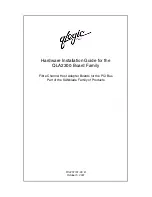
Hardware Reference Guide
67
P
RODUCT
O
VERVIEW
Antennas
The AP330 has internal antennas, and the AP350 connects to detachable ones. Antennas for both models
are described below.
AP330
The AP330 has six internal single-band antennas. Three of the antennas operate in the 2.4 GHz band (IEEE
802.11b/g/n) with a 2-5 dBi gain. The other three antennas operate in the 5 GHz band (IEEE 802.11a/n)
with a 3-6 dBi gain. All antennas are omnidirectional and provide fairly equal coverage in all directions.
AP350
The AP350 has six male 802.11a/b/g/n RP-SMA (reverse polarity-subminiature version A) connectors for
attaching external up to six single-band dipole antennas. Articulated and non-articulated antennas are
available as accessories. The articulated 2.4 GHz and 5 GHz antennas have a 4-dBi gain. The
non-articulated 2.4 GHz and 5 GHz antennas have a 2-dBi gain. These antennas are omnidirectional,
providing fairly equal coverage in all directions in a toroidal (donut-shaped) pattern. For greater
coverage on a horizontal plane, it is best to orient the antennas vertically. So that you can easily do this
whether the AP is mounted horizontally or vertically, the articulated antennas hinge and swivel. The
non-articulated antennas are intended for wall installations and have a fixed orientation in the same
direction as the antenna connectors. For more information about configuring antennas for the best
coverage, see
"Configuring Antennas" on page 115
.
Connect the 2.4 GHz and 5 GHz antennas to the connectors with the corresponding 2.4 GHz and 5 GHz
labels. In addition to being labeled, the 5 GHz antenna connectors are within gray circles that match the
gray grips near the base of the 5 GHz antennas (see
Figure 3 AP350 antennas
Nonarticulated antenna
Articulated antenna
Length when
fully extended:
5 3/4” (14.6 cm)
Length when
hinged at 90°:
4 7/8” (12.4 cm)
Length:
3 1/2” (8.9 cm)
Attach the 2.4 GHz antennas (white
connector rings) to the connec-
tors labelled 2.4 GHz.
Attach the 5 GHz antennas (gray
connector rings) to the connec-
tors labelled 5 GHz with gray
Use articulated antennas when you must angle them for optimal coverage;
for example, a ceiling mount with all six antennas pointing down.
Use nonarticulated antennas when you
can position the AP to determine
antenna orientation; for example, a
wall mount with three antennas
pointing up and three pointing down.
Antennas and connectors are
labeled and color-coded for easy
installation.
Summary of Contents for BR200-WP
Page 1: ...Aerohive Hardware Reference Guide...
Page 2: ......
Page 10: ...Contents 8 Aerohive...
Page 28: ...Chapter 2 AP121 and AP141 Platforms 26 Aerohive...
Page 42: ...Chapter 3 The AP170 Platform 40 Aerohive...
Page 74: ...Chapter 6 AP330 and AP350 Platforms 72 Aerohive...
Page 98: ...Chapter 9 BR200 and BR200 WP Routers 96 Aerohive...
Page 110: ...Chapter 11 The HiveManager Platform 108 Aerohive...
Page 124: ...Index 122 Aerohive...
















































